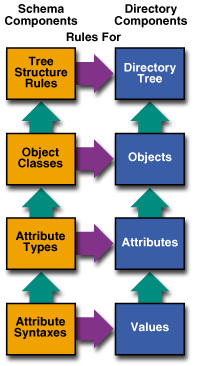1.1 Schema Structure
The schema defines the set of rules that govern the types of objects that can exist in an NDS™ tree. Each object belongs to an object class that specifies which attributes can be associated with the object. All attributes are based on a set of attribute types that are, in turn, based on a standard set of attribute syntaxes.
The NDS schema not only controls the structure of individual objects, but it also controls the relationship among objects in the NDS tree. The schema rules allow some objects to contain other subordinate objects. Thus the schema gives structure to the NDS tree.
The figure below shows how the schema components and the NDS components are interrelated. The vertical arrows indicate the structure dependencies from the basic building blocks up to the NDS schema and the NDS tree, respectively. The horizontal arrows denote the schema rules that apply to the respective NDS components.
Figure 1-1 The Relationship between Schema Components and NDS components

The attribute syntaxes define the primary data types for values stored in the NDS tree. Attribute types are defined from the attribute syntaxes and define the possible attributes an object can have. Object classes are defined using a subset of the possible attributes and determine the types of objects that can be in the tree. The tree structure rules define how the object classes can be organized and nested in the tree, and therefore determine the tree’s structure.
Objects that can contain other objects are called container objects. Container objects are the building blocks of the NDS tree. Objects that cannot contain other objects are known as noncontainer or leaf objects. Leaf objects comprise the actual network resources such as a user, a server, or a printer.
See Also:
1.1.1 Structure Rules
The Structure Rules define the relationships between objects in the NDS tree. These relationships are defined by two properties:
Containment classes determine where the object can appear in the NDS tree relative to other classes of objects. Naming attributes-sometimes called Named By attributes-determine how the object is named.
1.1.2 Distribution of the NDS Schema
The NDS schema is global. Each server stores a replica of the schema in its entirety. The schema replica is stored separately from the partitions that contain directory objects. Changes to any one schema replica are propagated to the other replicas. You can perform modifications to the schema only through a server that stores a writable replica of the root partition. Servers storing read-only replicas of the root partition can read but not modify schema information.